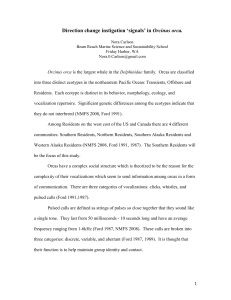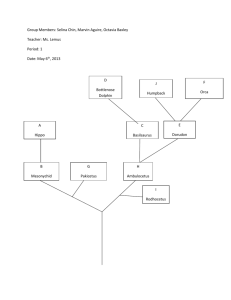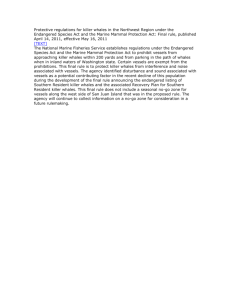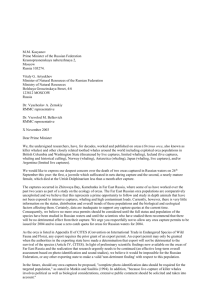NoraPaperRough
advertisement
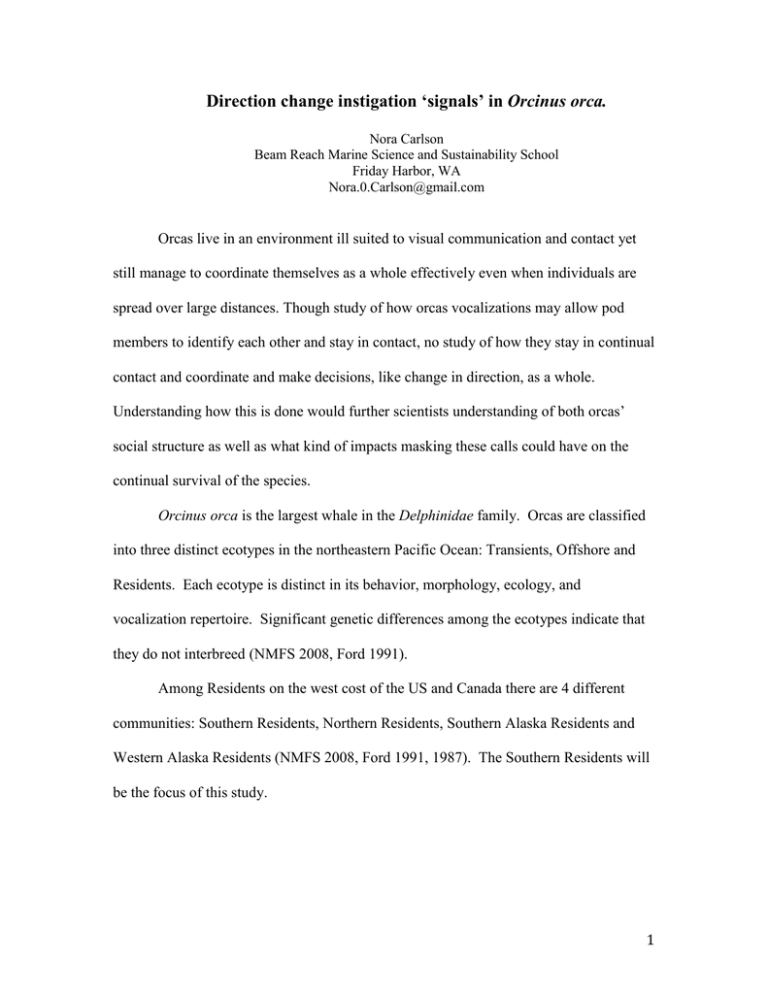
Direction change instigation ‘signals’ in Orcinus orca. Nora Carlson Beam Reach Marine Science and Sustainability School Friday Harbor, WA Nora.0.Carlson@gmail.com Orcas live in an environment ill suited to visual communication and contact yet still manage to coordinate themselves as a whole effectively even when individuals are spread over large distances. Though study of how orcas vocalizations may allow pod members to identify each other and stay in contact, no study of how they stay in continual contact and coordinate and make decisions, like change in direction, as a whole. Understanding how this is done would further scientists understanding of both orcas’ social structure as well as what kind of impacts masking these calls could have on the continual survival of the species. Orcinus orca is the largest whale in the Delphinidae family. Orcas are classified into three distinct ecotypes in the northeastern Pacific Ocean: Transients, Offshore and Residents. Each ecotype is distinct in its behavior, morphology, ecology, and vocalization repertoire. Significant genetic differences among the ecotypes indicate that they do not interbreed (NMFS 2008, Ford 1991). Among Residents on the west cost of the US and Canada there are 4 different communities: Southern Residents, Northern Residents, Southern Alaska Residents and Western Alaska Residents (NMFS 2008, Ford 1991, 1987). The Southern Residents will be the focus of this study. 1 Orcas have a complex social structure which is theorized to be the reason for the complexity of the use and structure of their vocalizations. There are three categories of vocalizations: clicks, whistles, and pulsed calls (Ford 1991,1987). Pulsed calls are defined as strings of pulses so close together that they sound like a single tone. They last from 50 milliseconds - 10 seconds long and have an average frequency ranging from 1-6kHz (Ford 1987, NMFS 2008). These calls are broken into three categories: discrete, variable, and aberrant (Ford 1987, 1989). It is thought that the function of pulsed calls is to help maintain group identity and contact. Clicks are very short bursts of sound that have been observed to occur frequently when orca are active (Ford 1989), though they also occur during resting behavior. Click rates vary and can occur from very few to over 300 clicks per second. Clicks are heard produced in three patterns, single clicks, click trains which are a series of clicks occurring with 2 seconds or less between clicks, and buzz trains which are clicks produced so close together that they have no audible separation between individual clicks. Clicks are thought to be used mostly for navigation and foraging, but since they also occur during social interaction, and it is hypothesized that information from clicks is shared, it is thought that they may serve a communicative function as well (Barrett-Lennard et al. 1996, NMFS 2008). Whistles are continual tonal calls that last about .06 - 18.3 seconds. They have a high average dominant frequency of 8.3kHz. In most whistles, there are harmonics around a fundamental frequency (Thompson et al. 2001). Whistles, like discrete calls, have discrete and variable call types (Reisch et al. 2006). Among the Southern Residents, whistles are most commonly used both during foraging and socializing 2 (NMFS 2008, Ford 1987, 1989), and in situations when the individuals of the pod are more than 10m away from each other (Barry 2006). Orcas’ complex social structure is mirrored in the existence of dialects that differ among clans, pods and matrilines. Dialects are characterized by differences in vocal repertoires and acoustics (Ford 1991). Because light doesn’t travel very far in water but sound does, it is theorized that marine animals must rely on sound to keep in contact with each other (Myberg 1980 in Miller et al. 2004). Vocalizations are very important when studying marine mammal behavior because they are a large part of how animals interact with one another and observing their physical behavior can be extremely difficult. As one of the only ways scientists are able to research free-ranging orcas, decoding the information in sounds is very important to understanding both their communication and behavior. Understanding how they communicate and what drives their behavior will help scientists better understand the impacts of human presence in their habitat and thus orcas’ ability to not only thrive but to survive. Both Bigg et al. (1987) and Ford (1987, 1991) thought that discrete pulsed calls were significant because of their frequent occurrences and their use in defining the differences among dialects. Recently Reich et al. (2006) documented discrete whistle types. Both Thomson et al. (2001) and Reisch et al. (2006) found that orca whistles are much more complex than previously suspected, and, among Northern Residents, most commonly occur during socializing behavior leading scientists to believe that, like discrete pulsed-calls, they are important to communication. Because Southern Residents 3 have the highest whistle rate during resting and when individuals are spread greater than 10m, Barry (2006) theorized that whistles may have a communicative function. Miller (2004) found that orcas exhibit call-type matching behavior, in which after one whale calls, another will often respond with the same or very similar call. He also found that of the one or two most frequent calls produced, those calls tend to be repeated in a series a significant (p = .0001) percent of the time. Weiland (2007) found something similar: that the most frequent call had patterns of repetition and that the calls are not random sounds, leading to the idea that the calls are structured enough to be classified as communication. Although the aforementioned scientists have found many interesting call pattern occurrences, no study on the existence of direction change instigation calls in freeranging orcas has been pursued. This topic warrants further study because knowledge of behavior triggering patterns in vocalizations may allow biologists to better understand behavioral trends and patterns as well as group cohesion and decision-making. In addition, this knowledge would allow biologists and conservationists to understand how behaviors may be changed by outside influence. It would further scientists’ ability to study short and long term behavioral shifts due to factors such as food quantity, disruptions in orca movements and activities. It would also allow scientests to understand if masking (covering up) calls could result in pod dispersal and the unintentional separation of individuals from the pod. It is common in some terrestrial animals and birds for an individual to signal for group movement or change of foraging area (Radford 2004, Boinski 1993, 1996, Bradbury 1998). Green woodhoopoes, white-faced capuchin monkeys and squirrel 4 monkeys have been found to have certain calls that instigate troop movement and direction change. (Radford 2005, Boinski 1993, 1996, Boinski & Campbell 1995). Boinski & Campbell (1993, 1995) found that white-faced capuchins’ trills occurring during movement served to maintain contact, directionality and trajectory. They found that trills were the only call that triggered group movement and orientation demonstrated by white-faced capuchins who were visually separated from their group and who would periodically orient themselves to the others but only in response to a trill (Boinski 1993, Boinski & Campbell 1995). The Pacific Ocean is, in some ways, not that different from the forests in which woodhoopoes, squirrel monkeys and white-faced capuchins live. In these kinds of habitats visibility is low when individuals spread out during travel and foraging, making vocalization vital to group cohesion, movement, direction and identity (Radford 2004, Boinski 1993, 1996). In light of these similarities in habitat which could lead to similarities in group movement initiation and the fact that before direction changes in capuchin monkeys a higher rate of trills is produced because direction change only occurs after an individual ‘signals’ a direction change by repeatedly trilling at a much higher rate than normal, I have decided to focus my study on the following questions: Does a higher call rate occur shortly before direction change? Does a higher buzz rate occur shortly before direction change? To investigate these questions I tested the following hypotheses: 1. Prior to pod direction change, calls occur at a higher rate than after pod direction change. 2. Prior to pod direction change, buzzes occur at a higher rate than after pod direction change. 5 Methods In order to gather data which would allow me to investigate whether pod direction change is instigated by a vocal signal—a vocal signal being a call or buzz rate change—I undertook three types of data gathering: acoustic recording, behavioral observation and data mining (finding and utilizing historical data). Due to the infrequent and brief encounters with the Southern Residents, historical data was used for most of the study data. This data was obtained from Dr. Otis at the Lime Kiln lighthouse. The behavioral data I obtained was taken from spreadsheets spanning 2001 to 2008. This behavioral data was taken only when the whales were inside a pre-designated study area in front of the lighthouse. Behavioral data, and sometimes, acoustic recordings would begin when the whales entered the study area and end when they left the study area. For every observation period the number of whales were counted and the occurrence of a turnaround (North to South and vice versa) was noted; the time of turnaround was also noted on many of the spreadsheets, more reliably so in more recent years due to the time of turn around being perceived as more important. The acoustic data from Lime Kiln was collected from 2001 to 2008 from various hydrophones maintained by The Whale Museum. The recorders’ sampling rate was 44.1 kHz and hydrophones had adequate response to record killer whale calls. Recordings were stored on an external hard drive as .wav files labeled using a year_month_day_hour_minute_second model so as to keep track of the start time for 6 each. These recordings were taken sporadically throughout the years so only some of the behavioral data had corresponding audio recordings. Additionally I collected my own data from a 42’ electric motor powered catamaran named Gato Verde which was used as a mobile research platform for orca observation. Data was taken among the San Juan Islands, the waters which the Southern Residents frequent most often during summer. During observation times, the Gato Verde was kept at least 100m from the orcas when traveling parallel to them and 400m from the path of the whales at all times as suggested by the Whale Watch Guidelines. Acoustic Study The acoustic data from Lime Kiln was collected from the external hard drive on which they were stored. Using the date and time from a spreadsheet and matching .wav file labels, the recordings were paired with the behavioral data and analyzed using Audacity version 3.1.12-beta (Unicode) (downloaded from http://audacity.sourceforge.net/). To obtain the acoustic data during studies on the Gato Verde a Lab Core 4 hydrophone array, with a frequency response curve with peak sensitivity at 5kHz connected to two Sound Device 702 solid-state audio recorders was used. The hydrophones were each approximately 10 meters apart (1-2 is 9.93m, 2-3 is 9.78m, 3-4 is 9.96 m) beginning with hydrophone number one, the one closest to the stern port engine; the hydrophones were deployed horizontally behind the Gato Verde. The hydrophones were positioned approximately 3.75 meters (depending on our speed) under the surface of the water by a weight of 8 lb. and were spaced beginning 7 approximately 6.5 meters (depending on our speed) from the stern port engine of the Gato Verde. This kept the hydrophones from getting caught on the motors of other ships passing too close to the stern of the boat. The Sound Device’s gains were set at 37 dB and the sampling rate was 44.1 kHz with a 16-bit depth. When the orcas were present and vocalizing, the hydrophones were turned on and recording began in real time. The start time of every .wav file was recorded, so the acoustic and behavioral data could be compared accurately. Behavioral Study The behavioral portion of this research focused on pod direction change. I defined a direction change as any change in direction that was of an angle between 90° and 180° from a previous direction. The new direction heading had to be kept for at least 12 minutes, so milling behavior and non-directional movement were not counted as changes in direction. A change in direction was not recorded unless it occurred when approximately 70% of the pod changed direction. The behavioral data from Lime Kiln was taken from the master sheet, combined and organized on a separate sheet in the following columns: Date, behavioral data start and stop time, recording start and stop time, number of whales, and direction change time. The behavioral data taken onboard the Gato Verde was recorded on one data sheet containing the following three columns: time, direction and number of whales. Each data sheet included the acoustic file number as well as the time the recording was started 8 allowing the audio and behavior data to be matched for analysis. I used continuous all occurrence sampling to collect the behavior data on the data collection sheet. For each research encounter with the orcas the number of individual whales within visual range was recorded in order to have the information necessary to calculate a call rate/individual/minute. During both recording sessions the number whales were counted in their entirety due to the fact that all the whales present were in close enough proximity to the research vessel that they could be seen and counted b the naked eye. The number of individuals was counted at the beginning of the encounter and if a change in numbers occurred the new number was recorded with the time at which the change occurred. These numbers were compared with the number of individuals that other researchers on Gato Verde counted and were consistent with their numbers. Analysis Calls were defined as any discrete, aberrant or variable call or whistle. Buzzes (Figure 1) were defined as a series of independent (not attached to a call) clicks so close together that individual clicks could not be discerned from one another. S37 (Figure 2) is an example of a buzz attached to a call; in that case therefore the buzz was counted as a call not a buzz. 9 Figure 1. A spectrogram of a buzz. Figure 2. A spectrogram of an S37 call. The total number of calls occurring during the six minutes before and after a direction change was acquired by importing a .wav file to Audacity and simultaneously watching the continuous spectrogram and listening to the recording. Every time a call was heard it was marked down so a final tally could be taken of all the calls during the six minute analyzed period. To get call rates the total number of calls for the six minutes before and six minutes after the direction change was divided by the number of whales present and the six minutes over which the calls were recorded. This data was square root transformed, to normalize the variance, before running a paired t-test. Buzz rate acquisition during the six minutes before and after direction changes followed the same protocol as call rates. The data was then Log10 transformed, to normalize variance, before a paired t-test was run. The behavioral and acoustic data were examined together to determine whether or not there was a significant difference between call and buzz rates six minutes before and after the direction change. The data collected constrained the amount of time before 10 direction changes that could be analyzed and six minutes before and after was the best compromise between number of analyzable instances and a longer amount of time in which direction change instigation calls could occur. To investigate whether or not there was a difference in the call and buzz rates before vs. after direction change a paired t-test was used. This test was chosen as it accounted for the inherent relationship between the call rates before and after individual direction change events. Results Twenty-six direction change events recorded between 2001 and 2010 were analyzed; of these twenty-six direction change events twenty-four were acquired from Dr. Otis and had been recorded between 2001-2008. The other two were recorded by me in 2010. During the years 2001-2008, whales were present and observed from about May 20th to August 10th. Observational periods lasted 39 minutes on average with and average of 81 observations a year. During these observational periods an average 22% had a direction change event and of those events only about 17% of them had usable recordings. After the data was acquired the number of calls and buzzes six minutes before and after every direction change event were entered into a Microsoft Excel sheet for organization and analysis. Call rates were calculated for each event by dividing the number of calls by number of whales present and the six-minute time duration. The call and buzz rates variances were normalized using a square root and a log 10 transform respectively. Call and buzz rates before and after direction changes were compared by 11 running a paired t-test using the program StatPlus:mac LE version 5.8.0.0/Universal (downloaded from http://www.analystsoft.com/en/products/statplusmacle/)used in conjunction with Excel:mac version 12.2.4. Call rates six minutes before direction changes, with an average (SEM) of 1.05 (0.4), were higher than call rates six minutes after, with an average of 0.82 (0.27), but not significantly so (t = 2.06, N = 26, p = 0.60) see Figure 3. Call Rate 1.60 call/whale/minute 1.40 1.20 1.00 0.80 0.60 0.40 0.20 1.05 0.82 0.00 Before Direction Change After Direction Change Figure 3. The mean (±SEM) call rates occurring six minutes before and six minutes after a direction change (t = 2.06, N = 26, p = 0.60). Buzz rates six minutes before direction change with a mean (SEM) of 0.18 (0.08) were significantly (t = 2.06, N = 26, p = 0.006) larger than buzz rates six minutes after with a mean of 0.05 (0.02) see Figure 4. 12 Buzz Rate buzzes/whale/minute 0.30 0.25 0.20 0.15 0.10 0.05 0.18 0.05 0.00 Before Direction Change After Direction Change Figure 4. The mean (±SEM) call rates occurring six minutes before and six minutes after a direction change (t = 2.06, N = 26, p = 0.006). Discussion Scientists have been trying to link pulsed calls and whistles with behavioral states and meaning for a very long time and have yet to succeed. My results follow this trend. There is no significant difference between call rates before and after direction change leading me to believe that my first hypothesis was incorrect. Because the meanings behind orca calls continue to evade us, scientists may not be focusing attention on the most important aspects of calls. Calls may be much more complex and have inherent patterns that we have yet to understand that are instrumental in information transmission. Scientists may also be assuming that there is much more or less complexity than actually exists in orca calls. 13 Scientists may be analyzing and categorizing calls incorrectly. The way calls are categorized is based on differences among the sounds as can be seen, measured and heard by humans and machines. We don’t receive orca calls the same way orca do meaning that we may be missing the differentiating aspects of calls. There have been no playback studies performed on wild populations to see if our categorization of calls is correct or not. The differences we see on a spectrogram or hear on a .wav file may not be as important to orca, and the more subtle differences we usually deem ‘unimportant’ may be the differing factor to orca. My data shows that buzz rates occur significantly more frequently before direction changes than after. This leads me to believe that buzzes may serve another function outside of pure echolocation and supports my hypothesis that buzzes may be used to signal movement instigation. While I believe they still serve as echolocation clicks, their higher rate before pod coordinated direction change indicates that they may have an important communicative function as well. Buzzes are especially well suited to this because they can be produced at strengths that allow for the reflections to be received from distances of 100m or possibly more. Due to the fact that they are echolocation clicks the information gleaned from them can be shared by many members of the pod. One limiting factor is that they are produced with high directionality meaning that the source levels and acoustic information of the outgoing signal can be distorted if the receiver isn’t directly in the path of the signal. Buzzes have been seen as an extension of clicks and click trains since scientists have determined how each kind of vocalization was produced. Although clicks are commonly thought to be primarily for special navigation and foraging, it has been found 14 in bottlenose dolphins that echolocation clicks may not be used as heavily for object avoidance and hunting. Instead bottlenose dolphins use passive acoustic monitoring to forage and are not as deft as previously thought at avoiding objects (Wood & Evans 1980 in Barrett-Lennard 1996). This illustrates how little is actually known about the different uses for echolocation in odontocetes. In 1996 Barrett-Lennard found that click rates in Southern Residents increased the fewer animals there were which he interpreted as meaning that the information obtained by clicks is shared. If this is the case with single clicks and click trains (a click train being a steady stream of clicks occurring about every 2 seconds or less [Barrett-Lennard 1996]) then perhaps buzzes are shared as well, allowing group members to not only signal their intention to change direction, but give the other pod members more spatial information through the reflection of the buzzes. Although I reached some interesting conclusions in this study, there were many limitations. In many recordings the background noise at points, mainly caused by passing ship and boats but occasionally flow noise as well, was loud enough that it potentially masked the calls, making it difficult to determine accurate call and buzz rates. In the Lighthouse data, because the hydrophones were stationary and the whales weren’t, and my data, because the whales were spread out and moving faster than the Gato Verde in most cases, occasionally the whales would get far enough away or point away from the hydrophones making their calls hard to hear over background noise again making it difficult to get accurate counts of calls and buzzes. Although this was a problem, there were no trends in the data of calls being too soft either before or after direction change 15 meaning that if the data is being skewed, it is being done so randomly to both time periods. The matter of human error was doubly as pertinent in this data set because the data passed through more than one set of people. The historic data was recorded and entered into the computer by one person and then extracted and analyzed by another. The number of different researchers recording and transcribing heightens the possibility of data entry mistakes. Sound files were also sometimes mislabeled meaning that the sound file start time and the labeled start time may have been different, thereby affecting data analysis accuracy. Orcas generally turn around under water meaning that an exact time of direction change cannot be known; therefore, the observer must estimate the time of direction change and may record the change later than it actually occurs. I saw some evidence of this while analyzing the recordings. In a number of instances the orca would be engaged in what seemed to be a conversational bout during the time of a direction change. If this were true one would expect to hear a difference in amplitude as the whales turn either toward or away from the hydrophone, something I never heard during these ‘bouts’. The limitations of this study highlight the need for further and more rigorous investigation of the function of both buzzes and clicks outside of echolocation. Further studying when and how frequently buzzes and clicks occur during different behavior states, group spreads, speed and direction changes and occurrence in conversational bouts may shed some light on how ocra vocalizations are utilized together and apart for communication, group decision making and what effects masking these vocalizations may have on the population as a whole. Understanding how orca maintain group contact 16 and orientation with one another and coordinate movement could allow scientists to better understand what kind of effects anthropogenic noise could have on the overall behavioral patterns of orca and whether or not masking of these calls could lead to pod dispersal and separation or stranding of individuals. An understanding of how orca make group decisions could lead to a better understanding of their behavioral patterns as well as movement and seasonal patterns. Knowledge of methods of communication in orca may be very important to keeping the species from extinction. Acknowledgements I am very grateful to the faculty members of Beam Reach who include Jason Wood, Val Veirs and Scott Veirs for all of their assistance and guidance during this project. Thanks to Todd Shuster for captaining our research vessel the Gato Verde and to University of Washington Friday Harbor Labs for supplying a place for us to stay and learn while on land. Dr. Robert Otis and The Whale Museum for the use of their historical data. Ken Balcomb for his expertise and information on the orca’s movement. Lynn Weber/Roochvarg for editing this paper. 17 References Barrett-Lennard LG. Ford J K B, Heise K A. 1996. The mixed blessing of echolocation: differences in sonar use by fish-eating and mammal-eating killer whales. Animal Behavior 51:553-565. Barry C. 2006. Determining patterns of whistle use in southern resident killer whales, Orcinus orca. Beam Reach, Unpublished. Bigg M, Ellis M, Ford J K B, Balcomb K. 1987 Killer Whales: A study of their Identification, Genealogy & Natural History in British Columbia and Washington State. Nanaimo, BC: Phantom Press & Publishers Inc. Boinski S. 1996. Vocal Coordination of Troop Movement in Squirrel Monkeys (Saimiri oerstedi and S. sciureus) and White-faced Capuchins (Cebus capucinus). In: Noronk et al. Ed. Adaptive Radiations of Neotropical Primates. New York: Plenum Press. pp. 251-269. Boinski S. 1993. Vocal coordination of troop movement among white-faced capuchin monkeys, Cebus capucinus. American Journal of Primatology 30:85-100. Boinski S & Campbell A. F. 1995. Use of trill vocalizations to coordinate troop movement among white-faced capuchins: a second field test. Behaviour 132:875901. Bradbury J W, Vehrencamp S L. 1998. Principles of Animal Communication. Sunderland, Massachusetts: Sinauer Associates Inc. pp. 358-364. Ford J K B. 1991. Vocal traditions among resident killer whales (Orcinus orca) in coastal waters of British Columbia. Canadian Journal of Zoology 69:1454-1483. Ford J K B. 1989. Acoustic behavior of resident killer whales (Orcinus orca) off Vancouver Island, British Columbia. Canadian Journal of Zoology 67:727-745. Ford J K B. 1987. A Catalogue of Underwater Calls Produced by the Killer Whales (Orcinus orca) in British Columbia. Canadian Data Report of Fisheries and Aquatic Sciences. Canadian Journal of Zoology No. 633:1-165. Miller P J O, Shapiro A, Tyack P, Solow A. 2004. Call-type matching in vocal exchanges of free-ranging resident killer whales, Orcinus orca. Animal Behavior 67:1099-1107. Morton A B, John C G, Renee C P. 1986. Sound and behavior correlations in captive Orcinus orca. In: Behavioral Biology of Killer Whales. Kirkevold B C & Lockard J S. Ed. New York: A R Liss. pp. 303-333. 18 National Marine Fisheries Service. 2008. Recovery Plan for Southern Resident Killer Whales (Orcinus orca). Seattle, Washington: National Marine Fisheries Service, Northwest Region. National Marine Fisheries Service. 2004. A consensus coding scheme for killer whale behavior. SRKW Behavior Workshop, Seattle WA: NOAA NMFS NFSC. Osborne R W. 1986. Behavioral Biology of Killer Whales. In: Kirkevold B C and Lockard J S Ed. Behavioral Biology of Killer Whales. New York: A R Liss, Inc. pp. 211-249 Radford A N. 2004. Vocal coordination of group movement by Green Woodhoopoes (Phoeniculus purpureus). Ethology 110:11-20. Riesch R, Ford J K B, Thomsen F. 2006. Stability and group specificity of stereotyped whistles in resident killer whales, Orcinus orca, off British Columbia. Animal Behavior 71:79-91. Thomsen F, Franck D, Ford J K B. 2002. On the communicative significance of whistles in wild killer whales (Orcinus orca). Naturwissenschaften 89:404-407. Thomsen F, Franck D, Ford J K B. 2001. Characteristics of whistles from the acoustic repertoire of resident killer whales (Orcinus orca) off Vancouver Island, British Columbia. Journal of the Acoustical Society of America 109:1240-1246. Weiland M. 2007. Repertoire Usage of the Southern Resident Killer Whales (Orcinus orca) Thesis. Reed College. 19
